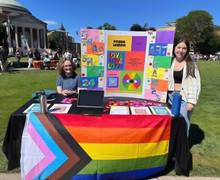NY data shows COVID-19 has disproportionately affected communities of color
Corey Henry | Senior Staff Photographer
Early data from the Centers for Disease Control and Prevention indicates that COVID-19 disproportionately affects populations of color.
Economic experts and public health officials said federal and state economic recovery efforts have helped some county residents in poverty stay afloat amid the coronavirus pandemic. But they expect poverty may still worsen, especially for those whose identities make them more vulnerable.
A June report by Syracuse-based PEACE, Inc. found that the people most vulnerable in the COVID-19 pandemic in Syracuse and Onondaga County are also those who struggle from well-established socioeconomic, institutional, health and racial inequalities.
Early data from the Centers for Disease Control and Prevention indicates that COVID-19 disproportionately affects populations of color. Despite making up 9% of the New York state’s population outside New York City, Black residents accounted for 18% of new cases of the virus in the state as of June, according to the PEACE, Inc. report.
In Onondaga County, Black or African American residents make up 11.4% of the population but accounted for 26.5% of hospitalizations in the county as of June.
The New York State Department of Health is searching for ways to close the gap of economic, racial and ethnic healthcare disparities, said Jeffery Hammond, public information officer for the department.
The state has opened walk-in and drive-thru coronavirus testing locations in low-income neighborhoods and launched a study on the impact of the virus on minority communities, Hammond said. The state has also provided millions of pieces of personal protective equipment and $25 million for food pantries, he said.
Federal aid efforts, such as the Coronavirus Aid, Relief and Economic Security Act, reduced the economic hardship caused by the immediate economic shut down and likely increased the rate of economic recovery in the region, said Colleen Heflin, a professor of public administration and international affairs at SU.
President Donald Trump signed the relief belief, also known as the CARES Act, into law March 27. The law intended to provide timely economic assistance for American workers and their families, as well as small businesses.
Arguments that aid efforts would prolong unemployment haven’t held up, Heflin said.
“There are some who argue that the high unemployment insurance benefits slowed the economic recovery because many workers wanted to stay unemployed so that they could receive the higher benefits than work provided, but the evidence for this is actually quite slim at this point,” Heflin said.
Historically, low poverty levels in 2019 and high median household incomes prior to the pandemic put most communities in a stronger position to weather the pandemic, she said.
“The strong economic position likely provided some buffer, both to households and businesses, as they experienced the COVID-created economic crisis,” Heflin said.
Gretchen Purser, an associate professor of sociology at SU, said it’s unfortunate that the CARES Act has not been extended. There still has not been a resurgence or increase in jobs during the pandemic, she said.
“I suspect the poverty levels are going to get worse,” Purser said. “However, there would’ve been more poverty without the CARES Act.”
The prospect of prolonged economic instability is alarming for those whose race or other identity might make them more vulnerable to recessions, groups such as PEACE, Inc. have argued.
The majority of the problems observed during the COVID-19 pandemic are not new, PEACE, Inc. wrote in its report. COVID-19 has instead exacerbated and intensified long-standing structural insecurities and inequalities.
Published on September 23, 2020 at 12:11 am





